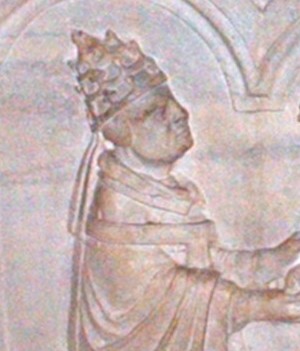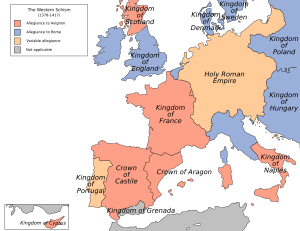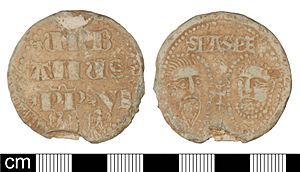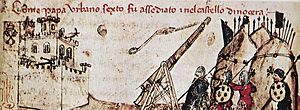Pope Urban VI facts for kids
Quick facts for kids Pope Urban VI |
|
|---|---|
| Bishop of Rome | |

Effigy of Urban VI contained in his funerary monument
|
|
| Church | Catholic Church |
| Papacy began | 8 April 1378 |
| Papacy ended | 15 October 1389 |
| Predecessor | Gregory XI |
| Successor | Boniface IX |
| Opposed to | Avignon claimant: Clement VII |
| Orders | |
| Consecration | 21 March 1364 |
| Personal details | |
| Birth name | Bartolomeo Prignano |
| Born | c. 1318 Itri, Kingdom of Naples |
| Died | 15 October 1389 (aged 70–71) Rome, Papal States |
| Coat of arms |  |
| Other Popes named Urban | |
Pope Urban VI (born Bartolomeo Prignano) was the leader of the Catholic Church from 1378 until his death in 1389. He was the last pope chosen who was not already a cardinal.
His time as pope started right after the Avignon Papacy ended. This was a period when popes lived in Avignon, France, instead of Rome. Urban VI's rule was full of big disagreements. These conflicts led to the Western Schism, a time when two different people claimed to be the true pope. Many parts of Europe recognized Clement VII, who was based in Avignon, as the real pope.
Contents
Early life
Bartolomeo Prignano was born around 1318 in Itri, a town that was part of the Kingdom of Naples at the time. He was a very religious monk and a skilled expert in church law, having studied in Avignon.
In 1364, he became the Archbishop of Acerenza in the Kingdom of Naples. Later, in 1377, he was made Archbishop of Bari. People knew Prignano for being simple and careful with money. He was also known for his love of learning. Some said he didn't have family members helping him get ahead, which was common back then. However, once he became pope, he did give important jobs to four of his nephews.
People described him as sometimes being very strong-willed and quick to anger. This made it hard for him to deal with important church problems, even though he wanted to make things better.
Election as Pope
When Pope Gregory XI died in March 1378, a large crowd in Rome surrounded the meeting where the new pope would be chosen. They demanded that a Roman be elected. The cardinals, who were the church leaders who elected the pope, felt a lot of pressure. They wanted to prevent the pope from moving back to Avignon.
So, on April 8, 1378, they all agreed to choose Bartolomeo Prignano. He was not a cardinal, so he wasn't very well known. He took the name Urban VI. Right after he was chosen, most of the cardinals quickly left Rome. They didn't want the crowd to find out that the new pope was not Roman, but from Naples.
Even though his coronation was done very carefully, showing he was the true pope, the French cardinals were not happy. They immediately started planning against him. Urban VI didn't help himself much either. The cardinals had expected him to be easy to control, but he seemed proud and angry to many people. Some thought that becoming pope had changed him.
A Divided Church
Soon after becoming pope, Urban VI started telling the cardinals off. He said that church business should be done without gifts or bribes. He also told cardinals they couldn't take money from rulers. He criticized their fancy lifestyles and how many church jobs they held. He also refused to move the papal seat back to Avignon. This made the King of France, Charles V of France, very unhappy.
The cardinals were very offended. Five months after his election, the French cardinals met in Anagni, Italy. They invited Urban, but he knew they might try to capture or even kill him. So he didn't go. On August 9, they announced that his election was not valid. They claimed they had been forced by the Roman crowd to elect an Italian.
Then, in Fondi, with secret support from the King of France, the French cardinals chose Robert of Geneva as pope on September 20. Robert, a military church leader, took the name Clement VII. This event started the Western Schism, which split the Catholic Church until 1417.
The French "antipope" declared Urban VI excommunicated (kicked out of the church). He even called Urban the "Antichrist". But Catherine of Siena, a famous saint, defended Urban. She called the cardinals "devils in human form." People at the time saw that this was a political fight, not just a religious one.
Urban VI quickly appointed 26 new cardinals. He also raised money for a war by selling church properties. In May 1379, Clement VII went to Avignon, where he was heavily influenced by the King of France.
Conflicts and Challenges
Urban VI's former supporter, Queen Joan I of Naples, stopped supporting him in 1378. This was partly because her former archbishop had become her feudal lord, meaning he had power over her lands. Urban then started making mistakes. He turned against Queen Joan, excommunicated her, and allowed a religious war to be preached against her.
Soon, Joan's enemy and cousin, Charles III, was made King of Naples in 1381 and crowned by Urban. Queen Joan lost her power, and Charles had her killed in 1382. In return for Urban's help, Charles promised to give some cities to Urban's nephew. However, once Charles was settled in Naples, he broke his promises.
In Rome, the Castel Sant'Angelo was attacked and captured. Urban was forced to run away. In 1383, he decided to go to Naples to pressure Charles in person. But there, he found himself almost a prisoner. After a brief peace, Charles became freer to resist Urban's demands. Urban was trapped in Nocera. From the castle walls, he would daily shout curses against those who were attacking him. A reward was even offered for his capture.
After six months of being under attack, Urban managed to escape to Genoa. He was rescued by two noblemen who supported him. Some of his cardinals who were with him in Nocera wanted to make a stand. They suggested that the Pope, because of his stubbornness, should be put under the care of one of the cardinals. Urban had them arrested and put to death. This was seen as a terrible crime by people at the time.
Urban's support had shrunk to only a few northern Italian states, Portugal, England, and Emperor Charles IV of Germany.
When Charles of Naples died in 1386, Urban moved to Lucca. The Kingdom of Naples was then fought over by Charles's son, Ladislaus, and Louis II of Anjou. Urban tried to use this confusion to take Naples for his nephew. He also managed to get Viterbo and Perugia back under papal control.
Injury and Death
In August 1388, Urban moved from Perugia with thousands of soldiers. To get money, he announced a special church event called a Jubilee for 1390. This was unusual because only 38 years had passed since the last Jubilee.
During the journey, Urban fell from his mule in Narni. He had to recover in Rome, where he managed to regain papal control over the city. He died soon after, on October 15, 1389. It is thought he died from the injuries of his fall, but some people whispered about poisoning. He was followed by Pope Boniface IX.
Later, when Saint Peter's Basilica was being rebuilt, Urban's tomb was almost thrown out. His stone coffin was nearly used to water horses. Luckily, a church historian named Giacomo Grimaldi arrived and recognized its importance, saving it from being destroyed.
See also
 In Spanish: Urbano VI para niños
In Spanish: Urbano VI para niños
- Cardinals created by Urban VI
- List of popes
- The Bad Popes




